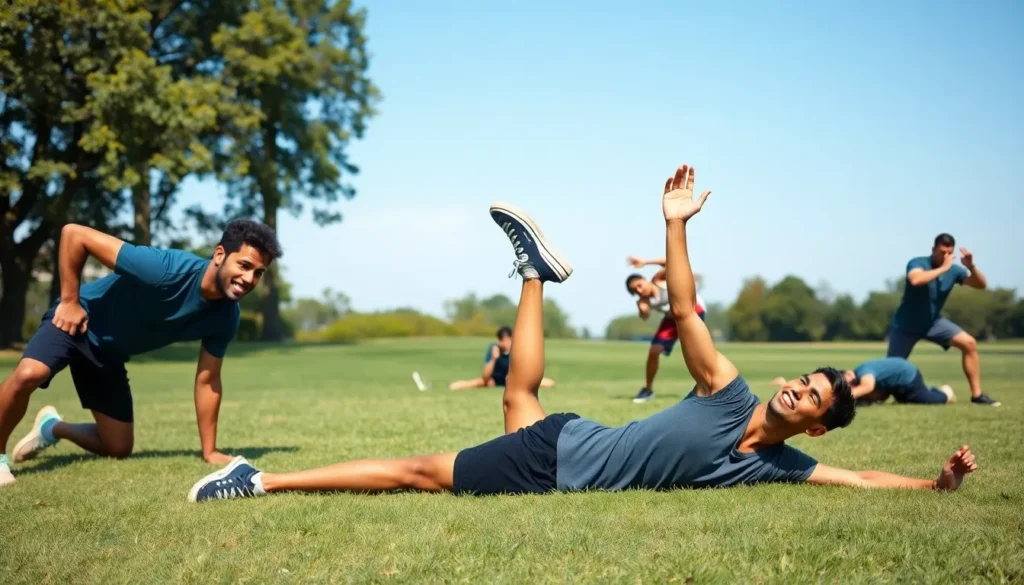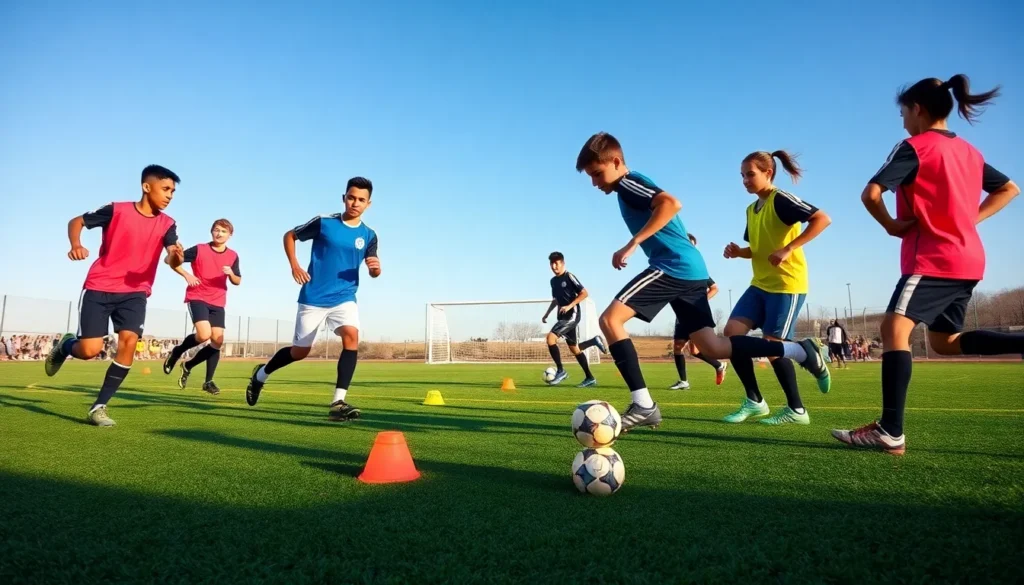In the world of fitness, a strong core is the unsung hero of every superhero. It’s not just about those chiseled abs; it’s about stability, balance, and the ability to conquer life’s everyday challenges—like lifting groceries or dodging that one friend who insists on giving unsolicited workout advice. Enter core engagement drills, the secret sauce to transforming a wobbly jelly belly into a fortress of strength.
Table of Contents
ToggleOverview of Core Engagement Drills
Core engagement drills consist of various exercises designed to improve core strength and stability. These drills not only activate the abdominal muscles but also engage the muscles of the back, pelvis, and hips. By focusing on multiple muscle groups, individuals can enhance their overall fitness performance.
Planks stand out as one of the most effective core engagement drills. In this position, individuals maintain a straight line from head to heels while supporting their weight on their forearms and toes. Another effective drill involves dead bugs, where practitioners lie on their backs, extend arms and legs, and alternate moving limbs while keeping the core engaged.
Russian twists offer an excellent way to improve rotational strength. This drill involves sitting on the ground, leaning back slightly, and rotating the torso to touch the ground on either side. Incorporating this movement activates both the obliques and the overall core, promoting better stability.
Superman exercises also contribute significantly to core engagement. In this drill, individuals lie face down and lift their arms and legs off the ground simultaneously. This movement engages the lower back and abdominal muscles, promoting a well-rounded core workout.
Incorporating these drills into a fitness routine leads to improved balance and posture. Enhanced core strength translates to better performance in various sports and daily activities, making these drills essential for anyone looking to elevate their fitness level. By consistently practicing core engagement drills, they can achieve notable improvements in strength and stability.
Benefits of Core Engagement Drills

Core engagement drills provide numerous benefits, contributing significantly to overall fitness and performance.
Improved Stability and Balance
Stability and balance improve with regular core engagement drills. Engaging the core activates deep stabilizing muscles, which provide support for the spine. Performing exercises like planks and dead bugs enhances proprioception, helping individuals better understand their body’s position in space. Better body awareness leads to improved posture, reducing the risk of injury during physical activities. Athletes particularly notice these enhancements during dynamic movements, allowing for quicker reactions and smoother transitions.
Enhanced Athletic Performance
Athletic performance sees notable improvement through consistent core engagement drills. Drills strengthen the muscles crucial for explosive movements, directly influencing speed and power. Stronger rotational strength from exercises like Russian twists contributes to improved performance in sports requiring agility. Increased core stability allows athletes to maintain control during complex movements, enhancing efficiency. Many athletes find that their endurance levels rise as their core becomes stronger, which positively affects their overall performance in various sports.
Key Types of Core Engagement Drills
Core engagement drills can be categorized into two main types: isometric exercises and dynamic exercises. Each type plays a crucial role in developing core strength and enhancing overall performance.
Isometric Exercises
Isometric exercises target core stability by maintaining muscle tension without actual movement. Planks exemplify isometric drills, requiring participants to hold a straight position from head to heels while balancing on forearms and toes. Side planks focus on engaging the obliques and improving lateral stability. Another option, hollow holds, encourages participants to lie on their backs with arms and legs lifted a few inches off the ground, reinforcing core control. These exercises emphasize proper form and endurance, benefiting athletes looking to improve stability during dynamic movements.
Dynamic Exercises
Dynamic exercises engage core muscles through movement, enhancing strength and control. Dead bugs serve as a key example, where individuals alternate arm and leg movements while keeping their backs flat against the ground. This promotes coordination and stability. Russian twists add a rotational component, targeting the obliques and improving overall core function. Superman exercises, which involve lifting arms and legs simultaneously, contribute to overall back and core strength. Including these drills in workouts leads to better agility and performance in various sports and everyday activities.
How to Incorporate Core Engagement Drills into Your Routine
Core engagement drills enhance core strength and improve performance across activities. Integrating these exercises into a regular routine promotes overall fitness.
Frequency and Duration
Aim for core engagement drills two to four times per week. Each session should include 10 to 20 minutes of targeted exercises. Consistency matters, so prioritize maintaining this frequency for optimal results. A combination of both isometric and dynamic drills maximizes benefits. For instance, doing three sets of planks followed by dead bugs contributes to well-rounded strength. Adding variety keeps workouts engaging, thus motivating individuals to stay committed.
Progression Techniques
Introduce progression techniques to keep workouts challenging and effective. Start with basic exercises and gradually increase complexity over time. For example, if performing planks, one can advance to side planks or plank variations with leg lifts. Increasing the duration of holds or the number of repetitions also enhances difficulty. Incorporating resistance bands or stability balls during drills can further challenge the core. Regularly revisit and adjust techniques based on performance to ensure continuous improvement.
Common Mistakes to Avoid
Engaging in core exercises can yield impressive results, but several common mistakes can hinder progress. Neglecting proper form often leads to ineffective workouts. Maintaining a straight line during planks is crucial; failure to do so risks straining the lower back. Additionally, rushing through exercises reduces their effectiveness. Taking time to focus on each movement strengthens muscle engagement.
Overtraining poses another significant risk. Practicing core drills every day may lead to fatigue and injury. Recognizing the importance of rest days ensures muscles recover and grow stronger. Underestimating the need for variety also limits overall improvement. Incorporating a range of drills, like dead bugs and Russian twists, engages multiple muscle groups for comprehensive strength.
Ignoring breath control can affect performance too. Proper breathing techniques enhance stability and endurance during exercises. Shallow breathing diminishes oxygen flow, impacting overall effectiveness. Moreover, failing to engage deeper core muscles leads to less-than-optimal results. Prioritizing muscle activation during workouts ensures better engagement and progress.
Forgetting to assess one’s limitations can also prevent improvement. Individuals should choose exercises that match their current fitness level and gradually seek to advance. Lastly, skipping warm-ups can increase the risk of injury. Preparing the body through light stretching primes muscles for rigorous activity.
By avoiding these common errors, individuals can maximize the benefits of core engagement drills, resulting in improved stability and performance that carry over into daily activities and sports.
Core engagement drills play a crucial role in enhancing overall fitness and performance. By focusing on both isometric and dynamic exercises, individuals can develop a strong and stable core that supports various physical activities. Consistent practice not only improves strength but also boosts balance and posture, which are essential for injury prevention.
Incorporating these drills into a regular workout routine can lead to significant benefits in athletic performance and daily tasks. By avoiding common mistakes and prioritizing proper form, individuals can maximize the effectiveness of their core training. Ultimately, a strong core is the foundation for improved agility and endurance, making core engagement drills an indispensable part of any fitness regimen.













